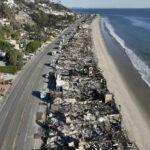The months-long natural gas leak that forced thousands of Los Angeles residents from their homes ranks as the largest known accidental methane release in U.S. history, equal to the annual greenhouse gas emissions of nearly 600,000 cars, scientists reported on Thursday.
At its peak, 60 tons per hour of natural gas was spewing from a ruptured underground pipeline at the Aliso Canyon storage field, effectively doubling the methane emissions of the entire Los Angeles metropolitan area, the researchers said.
Their study, published in the journal Science, represents the first comprehensive effort to quantify a gas leak that made scores of people ill and prompted the temporary relocation of more than 6,600 households from the northern Los Angeles community of Porter Ranch at the edge of the gas field.
The damaged injection well discharged a total of 97,100 tons – or 5 billion cubic feet (142 million cubic meters) – of methane into the environment from the time it was first detected on Oct. 23 until it was plugged earlier this month, the study said.
Methane, the chief component of natural gas and a far more potent greenhouse agent than carbon dioxide, persists in the atmosphere for 10 years. The total release from Aliso Canyon is equivalent to the annual energy-sector methane emissions of a medium-sized European Union country, it said.
“Our finding means that the Aliso Canyon leak was the largest accidental release of methane in the history of the U.S.,” Tom Ryerson, a scientist for the National Oceanic and Atmospheric Administration , and co-lead of the study, said in a NOAA statement about the research.
A 2004 accident in Texas actually expelled more natural gas but it was mostly consumed in an explosion and fire, so that methane never reached the atmosphere, the study said.
“Aliso Canyon will have by far the largest climate impact” and will “substantially impact the state of California greenhouse gas emission targets for the year,” the study said.
In terms of heat-trapping greenhouse potential, the volume of leaked methane was equivalent to putting 572,000 passenger cars on the road for a year, according to the scientists.
Aliso Canyon, owned by Southern California Gas Co , a division of San Diego-based Sempra Energy , is the fourth largest gas storage field of its kind in the United States.
The utility issued a statement late Thursday minimizing the extent of the greenhouse gas impact, citing earlier state Air Resources Board data showing that methane released at Aliso Canyon was equivalent to 2.4 million tons of carbon dioxide.
That amount, the utility said, represents less than 1 percent of California’s entire year-round greenhouse gas emissions, and about one-eighth of the all methane produced annually by dairy cows in the state.
Still, environmental groups have seized on the Aliso Canyon disaster in calling attention to hazards posed by the state’s aging fossil fuel infrastructure. The crippled well there was converted from oil production to gas storage in 1973.
The blowout has also triggered a wave of legal action. SoCal Gas has pleaded not guilty to criminal charges stemming from the leak, which prosecutors said the utility failed to report in a timely manner. Local, state and regional authorities, as well as dozens of residents, have also sued the company.
The study was based on data collected from airborne and ground measurements taken during the course of the leak and analyzed by teams from NOAA, the California Energy Commission, two University of California campuses and the University of Colorado at Boulder.




















 Bill Aims to Make Staged Accidents a Federal Crime
Bill Aims to Make Staged Accidents a Federal Crime  No Escape From Tariffs — Not Even for D&O Liability Insurers
No Escape From Tariffs — Not Even for D&O Liability Insurers  Lawsuits Accuse Insurers of Colluding to Drop Coverage in Fire-Prone Areas of California
Lawsuits Accuse Insurers of Colluding to Drop Coverage in Fire-Prone Areas of California  Wildfire Losses Cut Chubb Q1 Net Income 38%; Tariffs Create ‘Confusion’
Wildfire Losses Cut Chubb Q1 Net Income 38%; Tariffs Create ‘Confusion’ 



